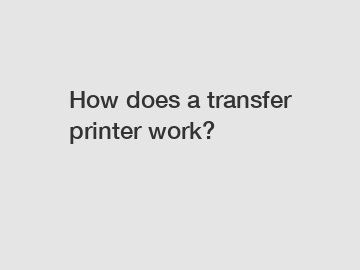How does a transfer printer work?
How does a transfer printer work?
Transfer printers are a common choice for printing high-quality images onto various materials such as fabric, ceramics, and even plastic. But have you ever wondered how these printers actually work their magic? In this article, we will explore the inner workings of a transfer printer and understand the step-by-step process behind its impressive capabilities.
1. Understanding the Basics of Transfer Printing:

Transfer printing is a technique used to apply an image or design onto a material by transferring it from a special transfer paper or film. The process typically involves three main components: a dye sublimation printer, transfer paper, and a heat press.
2. The Printing Process:
To begin, the image or design is created using graphic design software on a computer. The design is then printed onto special transfer paper using a dye sublimation printer. This printer uses heat to transfer dye onto the transfer paper, creating a reverse image of the desired design.
3. Preparing the Material:
Meanwhile, the material on which the image will be transferred needs to be prepared. For fabric, it usually involves ensuring it is clean and free from any contaminants that could affect the transfer process.
4. Placing the Transfer Paper:
Once the transfer paper is ready, it is placed on top of the material with the printed side facing down, ensuring that the image is in the correct orientation. The transfer paper is then secured onto the material using heat-resistant tape to prevent any movement during the transfer process.
5. Applying Heat and Pressure:
Next comes the crucial step of applying heat and pressure. The material, along with the transfer paper, is placed in a heat press machine. The heat press applies high temperatures, typically around 400°F (200°C), and pressure for a specific period, allowing the ink on the transfer paper to turn into a gas.
6. Sublimation Process:
The heat causes the solid dye particles on the transfer paper to change directly into a gas without becoming a liquid. This process is known as sublimation. The high temperature of the heat press opens up the pores of the material, enabling the gaseous dye molecules to penetrate its surface.
7. Image Bonding:
The gas molecules then cool down and solidify, bonding with the material's fibers. As a result, the image or design from the transfer paper becomes a permanent part of the material, ensuring durability and resilience.
8. Peel and Reveal:
After the recommended time has passed for the transfer process, the heat press is opened, and the material is carefully removed. It is crucial to do this while the material is still hot to prevent any damage to the transferred image. Once the material has cooled down, the transfer paper is peeled off, revealing the vibrant, high-resolution image that was transferred.
In conclusion, transfer printers utilize a combination of heat, pressure, and sublimation to create stunning, long-lasting images on various materials. The process involves printing the design onto transfer paper using a dye sublimation printer, and then using a heat press machine to transfer the image onto the chosen material through the sublimation process. With their ability to produce intricate designs and brilliant colors, transfer printers have become incredibly popular in industries such as fashion, home décor, and promotional merchandise. So next time you see a beautifully printed item, you will have a better understanding of how a transfer printer brings art to life.
If you are looking for more details, kindly visit laser vs thermal printer, when should i select a thermal barcode printer, barcode label software comparison.
51
0
0

Comments
All Comments (0)